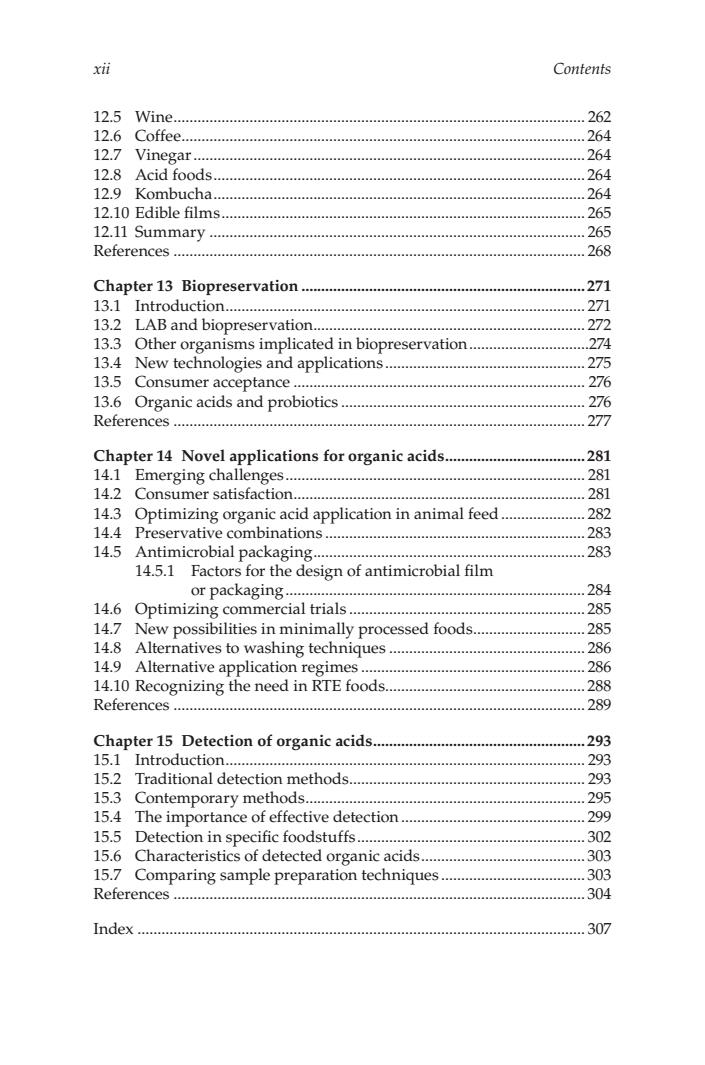正在加载图片...

xii Contents 125 Wine 26 Coffee. 26 gar. 264 .264 buc . .264 12.10 Edible films .265 12.11 Summarv. 265 References.... .268 Chapter 13 Biopreservation... 271 13.1 Introduction.. 271 13.2 LAb and biopreservation. 22 13.3 Other organisms implicated in biopreservation.........................74 13.4 New technologies and applications. .273 13.5 Consumer acceptance. 276 13.6 Organic acids and probiotics. 276 References .277 Chapter 14 Novel applications for organic acids .281 14.1 Emerging challenges. 281 14.2 Consumer satisfaction.. .281 14.3 Optimizing organic acid application in animal feed 282 5只2 14.5 A 14.51 design of antimicrobial filn or pac kaging. 2 14.6 Optimizing cmmercial trials 285 1 285 14.8 New possibilities in minimally processed foods Alternatives to washing techniques... 286 14.9 Alternative application regimes 286 14.10 Recognizing the need in RTE foods.. 288 References 289 Chapter 15 Detection of organic acids 293 15.1 Introduction..... .....293 15.2 Traditional detection methods. 293 15.3 Contemporary methods.. 295 15.4 The importance of effective detection. 290 15.5 Detection in specific foodstuffs.. 200 156 Characteristic of detected organic acids 202 15.7 Comparing sample preparatic n techniques 202 Reference 304 Index 307xii Contents 12.5 Wine....................................................................................................... 262 12.6 Coffee..................................................................................................... 264 12.7 Vinegar.................................................................................................. 264 12.8 Acid foods............................................................................................. 264 12.9 Kombucha............................................................................................. 264 12.10 Edible films........................................................................................... 265 12.11 Summary .............................................................................................. 265 References ....................................................................................................... 268 Chapter 13 Biopreservation ....................................................................... 271 13.1 Introduction.......................................................................................... 271 13.2 LAB and biopreservation.................................................................... 272 13.3 Other organisms implicated in biopreservation..............................274 13.4 New technologies and applications .................................................. 275 13.5 Consumer acceptance ......................................................................... 276 13.6 Organic acids and probiotics ............................................................. 276 References ....................................................................................................... 277 Chapter Novel applications for organic acids 14 ...................................281 14.1 Emerging challenges........................................................................... 281 14.2 Consumer satisfaction......................................................................... 281 14.3 Optimizing organic acid application in animal feed..................... 282 14.4 Preservative combinations ................................................................. 283 14.5 Antimicrobial packaging.................................................................... 283 14.5.1 Factors for the design of antimicrobial film or packaging........................................................................... 284 14.6 Optimizing commercial trials ........................................................... 285 14.7 New possibilities in minimally processed foods............................ 285 14.8 Alternatives to washing techniques ................................................. 286 14.9 Alternative application regimes ........................................................ 286 14.10 Recognizing the need in RTE foods.................................................. 288 References ....................................................................................................... 289 Chapter Detection of organic acids 15 ..................................................... 293 15.1 Introduction.......................................................................................... 293 15.2 Traditional detection methods........................................................... 293 15.3 Contemporary methods...................................................................... 295 15.4 The importance of effective detection .............................................. 299 15.5 Detection in specific foodstuffs......................................................... 302 15.6 Characteristics of detected organic acids......................................... 303 15.7 Comparing sample preparation techniques .................................... 303 References ....................................................................................................... 304 Index ................................................................................................................ 307